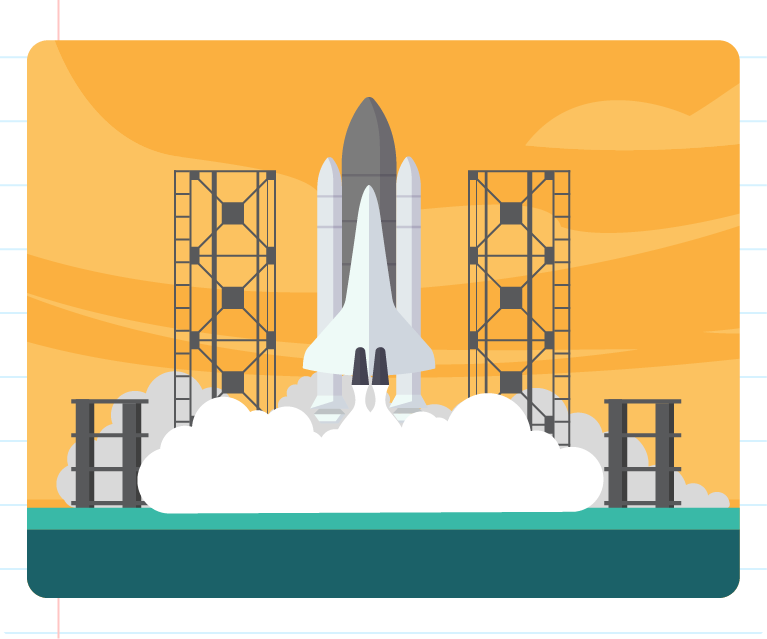| 10.2 |
Development of Technology and Their Application in Space Exploration |
History of space exploration:
-
On October 4, 1957, the Soviet Union successfully launched the world's first man-made satellite, Sputnik 1 into space
-
The first US satellite, Explorer 1, entered orbit on January 31, 1958
-
On April 12, 1961, Lieutenant Yuri Gagarin of Russia was the first human to orbit the Earth in his plane, Vostok 1
-
On July 20, 1969, U.S. astronaut Neil Armstrong became the first person to set foot on the surface of the Moon
-
Early 1970s communications and navigation satellites were widely used and the surface of Mars was surveyed by spacecraft, Mariner
-
In 1970, the Voyager aircraft sent out detailed images of Jupiter and Saturn
-
In the 1980s, satellites began to be used to transmit television programs and remote sensing technology that depicted the area destroyed by the Chernobyl nuclear power station in 1986
-
In April 1981, the Columbia spacecraft was ready for landing and reuse
-
The International Space Station is a research laboratory located in low Earth orbit produced by 15 countries
-
The International Space Station (ISS) was launched on November 20, 1998, and has been used in rotation by astronauts since November 2, 2000, for space research and mission purposes
-
As of January 2018, a total of 230 individuals from 18 countries have visited the ISS
A rocket:
-
A rocket is a type of cylindrical engine that is launched through the combustion of fuel
-
The rocket structure consists of 4 main systems namely, structural system, payload system, guide system, and propulsion system
-
The outer layer of the rocket is coated with a thermal protection system to protect the rocket from the heat generated and maintain a low temperature


-
The space shuttle is the world's first reusable spacecraft
-
The shuttle consists of three parts namely an orbiter, an outer tank, and a solid rocket booster
-
The three orbiters currently in operation are Discovery, Atlantis, and Endeavor
-
In 2012, SpaceX made history as the company that produced the first commercial spacecraft to successfully deliver cargo to the ISS
The satellite:
-
A satellite is a communication device that interprets a radio signal from the Earth, amplifies it and then responds to that signal
-
Various types of satellites are used such as weather forecasting, communication, television, navigation, and monitoring the situation on the Earth's surface (remote sensing)
Space probe:
-
A spacecraft is a type of spacecraft that travels in space to gather scientific information and does not carry astronauts but is controlled from Earth
-
Space probes are used to study the atmosphere and use radio signals
-
Three types of space probes, namely interplanetary to explore long distances, orbiters enter the orbits of the planets and landers (landers) land on the planets to collect information
-
The Cassini-Huygens spacecraft was launched on October 15, 1997 to study Saturn and took 7 years to reach Saturn
Remote sensing technology:
-
Remote sensing is the acquisition of information about an object or phenomenon without physically touching it
-
Satellites or airplanes equipped with tracking devices to detect and classify objects on the Earth's surface, atmosphere, and oceans based on reflected electromagnetic radiation
-
Active remote sensing involves a satellite or aircraft emitting a signal and reflecting the signal on an object detected by a detector on the same satellite and aircraft
-
Passive remote sensing involves satellites or airplanes that do not emit their own signals but only need to detect the reflection of sunlight from objects on the Earth's surface
-
The Malaysian Remote Sensing Agency (ARSM) or formerly the National Remote Sensing Center (MACRES) was established in 1988 under the Ministry of Science, Technology, and Innovation (MOSTI)
-
The objective of ARSM is to develop various remote sensing technology systems and other related technologies such as Geographic Information System (GIS), Global Positioning System (GPS), and Information and Communication Technology (ICT)
Example question:
In the event of a disaster where a radioactive power station explodes and massive contamination occurs, suggest the technology needed to survey the situation in the disaster area safely and at an immediate rate. Explain your answer.
Answer:
- Remote sensing technology.
- Remote sensing technology can detect the magnitude and extent of radioactive contamination using satellites.
- The results of remote sensing surveys can be obtained at an immediate rate without endangering human life.
Pros and cons of space exploration:
|
Pros
|
Cons
|
-
Add human knowledge and a deeper understanding of the world and the universe
-
Technology produced for space exploration applied in everyday life such as
-
Magnetic resonance imaging (MRI) in medicine
-
Memory foam technology used in pillows and mattresses
-
Creating more job opportunities
-
Research and studies for space exploration advancing the fields of science, technology, mathematics, and engineering (STEM)
|
-
High risk for astronauts. The failure of the last astronaut mission claimed the lives of a number of astronauts in 1986 (Orbiter Challenger) and 2003 (Orbiter Columbia)
-
Expensive is very high
-
It takes a long time to bear fruit
|